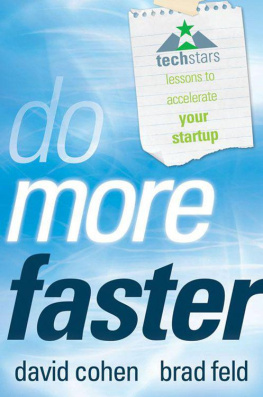Contents

Cover image: Light Ray TEEKID/iStockPhoto; Ripped Paper STOCKCAM/
iStockPhoto Cover design: C. Wallace
Copyright 2013 by Brad Feld and Jason Mendelson. All rights reserved.
Published by John Wiley & Sons, Inc., Hoboken, New Jersey.
Published simultaneously in Canada.
No part of this publication may be reproduced, stored in a retrieval system, or transmitted in any form or by any means, electronic, mechanical, photocopying, recording, scanning, or otherwise, except as permitted under Section 107 or 108 of the 1976 United States Copyright Act, without either the prior written permission of the Publisher, or authorization through payment of the appropriate per-copy fee to the Copyright Clearance Center, Inc., 222 Rosewood Drive, Danvers, MA 01923, (978) 750-8400, fax (978) 646-8600, or on the Web at www.copyright.com . Requests to the Publisher for permission should be addressed to the Permissions Department, John Wiley & Sons, Inc., 111 River Street, Hoboken, NJ 07030, (201) 748-6011, fax (201) 748-6008, or online at http://www.wiley.com/go/permissions .
Limit of Liability/Disclaimer of Warranty: While the publisher and author have used their best efforts in preparing this book, they make no representations or warranties with respect to the accuracy or completeness of the contents of this book and specifically disclaim any implied warranties of merchantability or fitness for a particular purpose. No warranty may be created or extended by sales representatives or written sales materials. The advice and strategies contained herein may not be suitable for your situation. You should consult with a professional where appropriate. Neither the publisher nor author shall be liable for any loss of profit or any other commercial damages, including but not limited to special, incidental, consequential, or other damages.
For general information on our other products and services or for technical support, please contact our Customer Care Department within the United States at (800) 762-2974, outside the United States at (317) 572-3993 or fax (317) 572-4002.
Wiley publishes in a variety of print and electronic formats and by print-on-demand. Some material included with standard print versions of this book may not be included in e-books or in print-on-demand. If this book refers to media such as a CD or DVD that is not included in the version you purchased, you may download this material at http://booksupport.wiley.com . For more information about Wiley products, visit www.wiley.com .
978-1-118-44361-3
To the best fathers on the planet:
Robert Mendelson and Stanley Feld.
Foreword
I wish I'd had this book when I started my first company. At the time, I didn't know preferred stock from chicken stock and thought a right of first refusal was something that applied to the NFL waiver wire.
Today, as the CEO of Twitter and the founder of three previous companies, the latter two acquired by public companies and the first acquired by a private company, I've learned many of the concepts and lessons in this book the hard way. While I had some great investors and advisers along the way, I still had to figure out all the tricks, traps, and nuances on my own.
My partners and I in our first company, Burning Door Networked Media, were novices so we made a lot of mistakes, but we managed to sell the company in 1996 for enough money to keep ourselves knee-deep in Starbucks tall coffees every morning for a year.
Several years later, my partners at Burning Door and I started a new company called Spyonit. This company did better and was sold to a public company called 724 Solutions in September 2000. Our stock was tied up for a year (we weren't that tuned into registration rights at the time) and when we got our hands on the stock in mid-September 2001, the collapse of the Internet bubble and the financial aftermath of 9/11 had caused our stock to decline to the point that it was worth enough money to keep us knee-deep in tall skim lattes at Starbucks every morning for a year.
So, like all good entrepreneurs, we tried again. This time, armed with a lot more knowledge and humility, we started FeedBurner in 2004. We raised several rounds of venture capital, including a seed round from DFJ Portage, a Series A round from Mobius Venture Capital (the firm Brad Feld and Jason Mendelson were part of at the time) and Sutter Hill, and a Series B round from Union Square Ventures. FeedBurner grew quickly, and before we knew it we had attracted acquisition interest from several companies, including Google, which purchased us in 2007 and allowed me to stop using coffee-purchase analogies to quantify the payout.
After spending several years at Google, I was recruited to join Twitter, where I now am the CEO. During my tenure with the company, Twitter has grown dramatically, from 50 people to more than 430 people, and has completed two major rounds of financing, having raised over $250 million.
When I reflect back on what I now know about VC deals, acquisitions, how VCs work, and how to negotiate, it's very satisfying to see how far I've come from that day back in the early 1990s when I co-founded Burning Door Networked Media. When I read through this book, I kept thinking over and over, Where were you when I started out? as the knowledge contained between these covers would have saved me a remarkable amount of time and money on my journey.
Brad and Jason have written a book that is hugely important for any aspiring entrepreneurs, students, and first-time entrepreneurs. But it's not just limited to themas I read through it I found new pearls of wisdom that even with all the experience I have today I can put to good use. And if you are a VC or aspire to be a VC, get in the front of the line to read this to make sure you are armed with a full range of understanding of the dynamics of your business. Finally, if you are a lawyer who does these deals for a living, do yourself a favor and read this also, if only to be armed with things to use to torture your adversaries.
Dick Costolo
Twitter CEO
March 2011
Preface
One of the ways to finance a company is to raise venture capital. While only a small percentage of companies raise venture capital, many of the great technology companies that have been created, including Google, Apple, Cisco Systems, Yahoo!, Netscape, Sun Microsystems, Compaq, Digital Equipment Corporation, and America Online (AOL) raised venture capital early in their lives. Some of today's fastest-growing entrepreneurial companies, such as Facebook, Twitter, LinkedIn, Zynga, and Groupon, were also recipients of venture capital.
Over the past 17 years we've been involved in hundreds of venture capital financings. Seven years ago, after a particularly challenging financing, we decided to write a series of blog posts that would demystify the venture capital financing process. The result was the Term Sheet Series on Brad's blog ( www.feld.com/wp/category/termsheet ), which was the inspiration for this book.
As each new generation of entrepreneurs emerges, there is a renewed interest in how venture capital deals come together. We encounter many of these first-time entrepreneurs through our activities as venture capitalists at our firm Foundry Group ( www.foundrygroup.com ), as well as our involvement in TechStars ( www.techstars.com ). We have been regularly reminded that there is no definitive guide to venture capital deals and as a result set out to create one.
In addition to describing venture capital deals in depth, we've tried to create context around the players, the deal dynamics, and how venture capital funds work. We've tossed in a section on negotiation, if only to provide another viewpoint into the brains of how a venture capitalist (at least the two of us) might think about negotiation. We also took on explaining the other term sheet that fortunate entrepreneurs will encounternamely the letter of intent to acquire your company.
Next page














